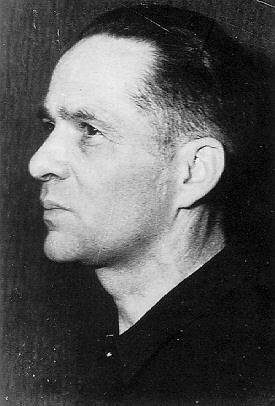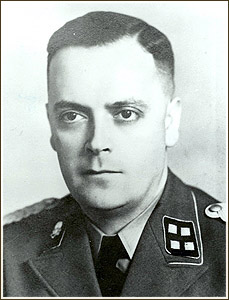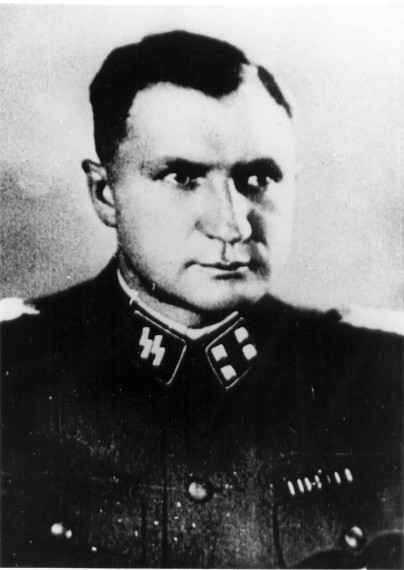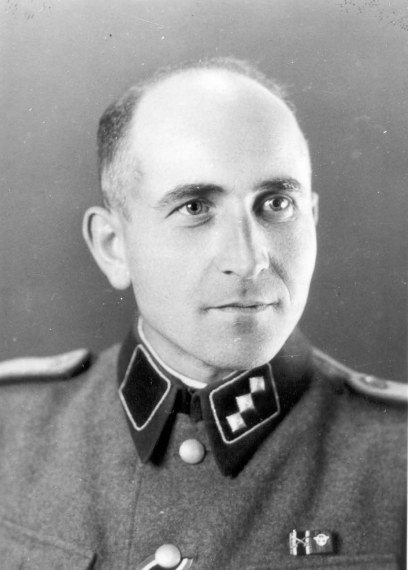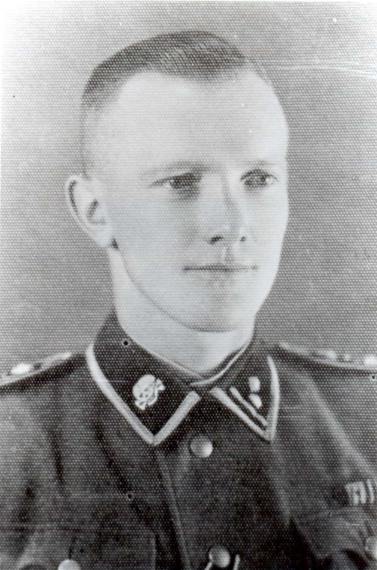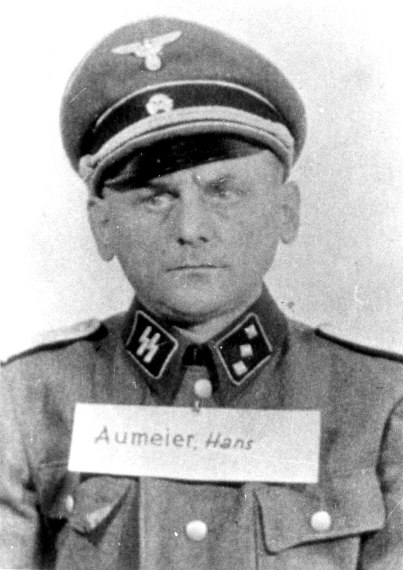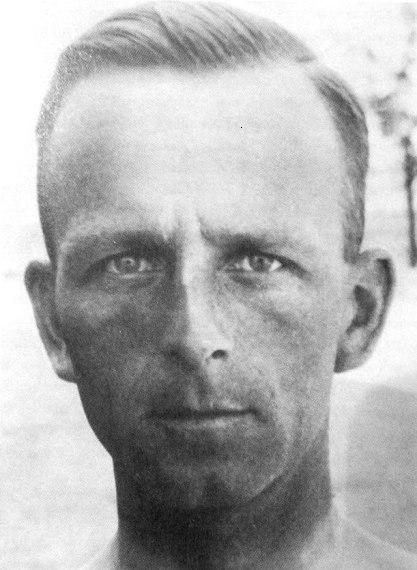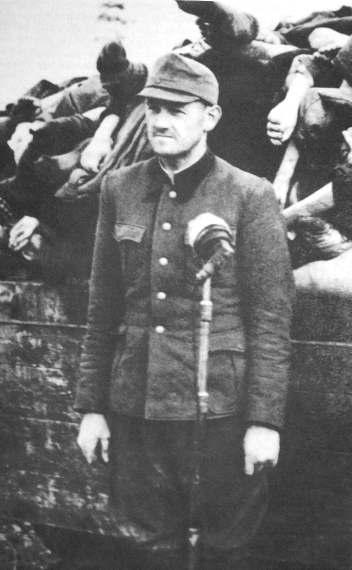Holocaust Education & Archive Research Team |
|
Other Camps
Key Nazi personalities in the Camp System The Labor & Extermination Camps
Auschwitz/Birkenau Jasenovac Klooga Majdanek Plaszow The Labor Camps
Trawniki
Concentration Camps
Transit Camps |
||||||||
Auschwitz Concentration Camp – Chain of Command
The Commandants
At the head of the concentration camp at Auschwitz stood the camp commandant who was responsible for all matters connected with the camp, particularly in relation to the security of the complex.
The camp commandant was at the same time the commander of the SS garrison and the director of the SS economic enterprises.
The first commandant of Concentration Camp Auschwitz was SS-Obersturnbannfuhrer Rudolf Höss, from 4 May 1940 to 10 November 1943.
The second commandant was SS- Obersturmbannfuhrer Arthur Liebehenschel from 11 November 1943 to 8 May 1944, and the third was SS-Sturmbannfuhrer Richard Baer from 11 May 1944 until the end of the camps existence in January 1945.
Employed in the camp command were the adjutant to the commandant, a staff sergeant and a legal officer. The mail censorship office was also located here.
After the division of the Auschwitz camp into three camps, the commandant’s of Auschwitz ll – Birkenau were SS-Sturmbannfuhrer Fritz Hartjenstein from 22 November 1943 to 8 May 1944 followed by SS-Hauptsturmfuhrer Josef Kramer from 8 May 1944 to 25 November 1944.
The commandant of Auschwitz lll – Monowitz was SS-Hauptsturmfuhrer Heinrich Schwarz from 22 November 1943 to the liquidation of the camp in 1945.
The Political Department
This was the representative arm of the RSHA in the camp and was independent of the commandant regarding its decisions as to the fate of prisoners, although it had to inform the commandant of these decisions.
The Political Department was divided into the following sections – registration, reception, registrar’s office, interrogation section, legal section and records division.
The Political Department sphere of activity embraced the following duties:
The Political Department was headed by an officer seconded from the Gestapo.
The first head of the Political Department was SS-Untersturmfuhrer Maximilian Grabner.
On 1 December 1943 the post was assumed by SS-Untersturmfuhrer Hans Schurz.
Camp Supervision
This department was concerned with all matters relating to the direct management of the camp, such as accommodating, feeding and clothing the prisoners, the prisoners labour activities and the maintenance of order in the camp.
The compound head – Schutzlagerfuhrer performed the function of deputy to the commandant, was responsible for reports on the camp complement and for internal order, recommending punishments and was present at executions and when punishments were inflicted.
To help him he had several camp marshals (Rapportfuhrer) who reported to him, block leaders (Blockfuhrer) and SS wardresses (Aufseherinnen) in the women’s camp. One of the most brutal Rapportfuhrer’s was Gerhard Arno Palitzsch, who was responsible for carrying out executions in the courtyard of Block 11.
The chief Lagerfuhrer of the main camp and later of Auschwitz l were in order of appointment:
The chief Lagerfuhrer of the men’s camp at Birkenau was SS-Obersturmfuhrer Johann Schwarzhuber, and the women’s camp from August 1943 to January 1944 Franz Hössler.
In the women’s concentration camp at Birkenau the function of chief supervisor was:
To help her the chief supervisor had supervisors who performed the functions of block leaders and heads of work gangs, corresponding to the functions of the Blockfuhrer in the men’s camp.
Department of Employment
This department was concerned with the employment of prisoners, the organisation of their work, the keeping of registers, the formation of work gangs, calculation of wages for prisoners employed by various enterprises and firms.
The prisoners during their working shifts were guarded by SS men, who were known as Postenfuhrer and Kommandofuhrer.
Administration
The tasks of this department included the management of the property of the camp, the supplying of the SS men and prisoners with food and clothing, heating, the maintenance of buildings, including the crematoria and financial matters.
It was in charge of all warehouses, including those containing the effects of the murdered, of the tailoring and repair shops, and also of the motor pool.
Until June 1943 the Administration constituted Department 1V of the camp command, on 1 July 1943 it was made an independent establishment bearing the name of Garrison Administration.
In September 1944 it was renamed the Central Administration of the Waffen SS.
The successive heads of the administration were:
· SS – Hauptsturmfuhrer Rudolf Wagner until the end of 1941 · SS- Sturmbannfuhrer Willi Burger until June 1943 · SS- Obersturmbannfuhrer Karl Mockel from July 1943
The Garrison Doctor
The SS Garrison doctor was responsible for the SS men’s state of health, for providing health care for the prisoners and for all sanitary installations throughout the Auschwitz complex.
The SS garrison doctor was responsible for the medical officers of the SS detachments who were responsible for treating the SS, the camp doctors who were responsible for the health of the prisoners in the camp, SS dentists and the camp pharmacist.
The SS camp doctors had assigned to them trained medical orderlies.
The successive garrison doctors were:
A number of doctors carried out selections in the camps and those sick were killed by injections of phenol into the heart.
Selections of the sick were conducted by the SS doctors Freidrich Entress, Erwin von Halmerson, Heinz Thilo, Edmund Konig, Josef Mengele and Bruno Kitt
The phenol injections were usually administered by the SS orderlies Josef Klehr and Herbert Scherpe, in Block 20 in the main camp. The Agricultural Department
The agricultural department was responsible for the development of farming and stockbreeding and also with research into experimental plant stations.
The agricultural department was managed by SS-Obersturmbannfuhrer Joachim Caesar
Central Construction Board
The Central Construction Board of the Waffen SS and Police at Auschwitz was directly subordinated to WVHA and was concerned with the planning, construction and extension of the Auschwitz camps and extermination facilities.
It was managed by SS-Sturmbannfuhrer Karl Bischoff and in 1944 by SS-Obersturmfuhrer Werner Jothann.
Sources:
Auschwitz Nazi Extermination Camp – Interpress Publishers Warsaw 1985 Holocaust Historical Society
Copyright SJ H.E.A.R.T 2007
|
